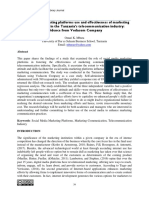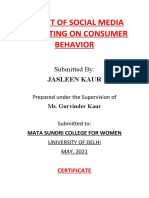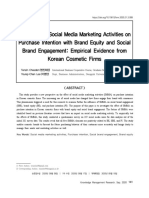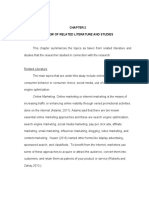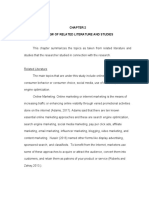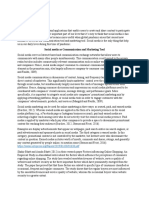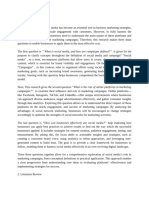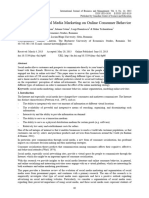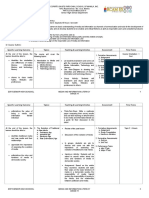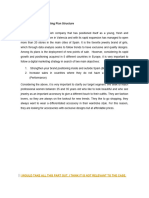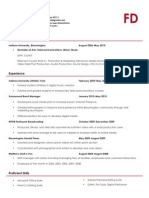Social Media Marketing Perspectives in The Organization in Morelia, Mexico
Social Media Marketing Perspectives in The Organization in Morelia, Mexico
Uploaded by
Bolo MadrigalCopyright:
Available Formats
Social Media Marketing Perspectives in The Organization in Morelia, Mexico
Social Media Marketing Perspectives in The Organization in Morelia, Mexico
Uploaded by
Bolo MadrigalOriginal Title
Copyright
Available Formats
Share this document
Did you find this document useful?
Is this content inappropriate?
Copyright:
Available Formats
Social Media Marketing Perspectives in The Organization in Morelia, Mexico
Social Media Marketing Perspectives in The Organization in Morelia, Mexico
Uploaded by
Bolo MadrigalCopyright:
Available Formats
International Journal of Marketing Studies; Vol. 8, No.
2; 2016
ISSN 1918-719X E-ISSN 1918-7203
Published by Canadian Center of Science and Education
Social Media Marketing Perspectives in the Organization in Morelia,
Mexico
Salvador Madrigal Moreno1, Gerardo Gabriel Alfaro Caldern1 & Flor Madrigal Moreno1
1
School of Accounting and Administrative Sciences, Universidad Michoacana de San Nicols de Hidalgo,
Morelia, Michoacn, Mxico
Correspondence: Salvador Madrigal Moreno, School of Accounting and Administrative Sciences, Universidad
Michoacana de San Nicols de Hidalgo, Michoacn, Mxico. E-mail: smadrigal@umich.mx
Received: January 21, 2016
doi:10.5539/ijms.v8n2p128
Accepted: February 13, 2016
Online Published: March 25, 2016
URL: http://dx.doi.org/10.5539/ijms.v8n2p128
Abstract
Social media marketing (SMM) is a reality in contemporary society. This research presents a review of the
literature on the phenomenon of SMM to establish the challenges and opportunities social media faces.
Subsequently, the digital inclusion in Mexico is discussed roughly focusing on the situation of SMM in the
organization in Morelia. The purpose of this paper is to contextualize the use of social media and establish the
challenges and opportunities of inclusion in communication strategies and marketing in the organization in
Morelia. It is confirmed that the contemporary society has established the conditions to implement properly
social media marketing in Morelia.
Keywords: social media marketing, digital inclusion, communication strategies
1. Introduction
In the context of contemporary society, information and communication technologies (ICT) have reshaped the
social dynamics, and they have been placed as a central and decisive element in organizations. The new
communication schemes have changed the dimensions of social and organizational life that seemed
unchallengeable, like time, space and even the perception of reality. From the high ownership of mobile devices,
like cell phones and tablets, the permanent availability is a fact. Social changes generated by ICTs have increased
in this contemporary society that has empowered the customer in such a way that if an organization wishes to
survive requires redesigning their communication and marketing strategies. That is, the organization must reduce
their reliance on traditional tactics of mass communication and marketing; understanding the role of technology
in the market and most importantly the participation of the social media as part of the toolbox of marketing that
must be seen as an important strategy (Constantinides, 2014). Speaking of social media, this refers to the use of
Internet-based and mobile devices to transform communication in a more interactive dialogue (Guliciuc, 2014).
Alternatively, a group of Internet-based applications that are based on ideological and technological principles
based on the Web 2.0 which allows the creation and exchange of user-generated content (Badea, 2014). When it
comes to the use of social media to market-related objectives is when it is possible to talking about the social
media as a marketing display.
As it occurs in any social phenomenon, social media marketing (SMM) involves a series of opportunities and
challenges, which on their own, create the necessity to be contextualized in a very particular way. Digital
inclusion is the key point to position marketing in the social media. This research provides an overview of the
conditions that digital inclusion is facing in Mexico. Given the lack of research that reveal the SMM in Morelia,
it is that this study is conducted to contextualize the phenomenon of SMM, and glimpse its potential in the
organization of Morelia. In this paper, a conceptual, theoretical approach to the phenomenon of SMM is
presented and then the assumption that different organizations in Morelia have about the research topic. The
results obtained indicate that SMM is a feasible option for the organization of Morelia to establish a direct and
permanent communication with any person they want so that the main risk of social media marketing for the
organizations in Morelia is not to implement it.
2. Methodology
This is an exploratory, descriptive and quantitative research. By analyzing secondary information (books,
128
www.ccsenet.org/ijms
International Journal of Marketing Studies
Vol. 8, No. 2; 2016
magazines, journals and reports), it is possible to identify the challenges and opportunities the SMM is facing.
Subsequently, through a survey used as a methodological tool a situational analysis of SMM in Morelia, Mexico
was established. The survey was applied to 50 organizations in Morelia. The structure of the survey consists of 6
questions: the first question would determine whether the organization had the minimum requirements for
installing social media as a marketing strategy. The second shows if the organization has already had any kind of
participation in the social media; from the second question the survey would lead the researcher to know what
the social media is most used by the organization on the one hand, and on the other hand, the reasons why they
are not using the social networks.
The structured survey questions were formulated from the frequency of variables found in the literature and the
information presented in the latest report from the report Habits of Internet Users in Mexico 2015, conducted by
the Mexican Internet Association (AMIPCI, 2015). The main objective of the survey was to identify the level of
appropriation of social media by organizations in Morelia. The study sample (not probabilistic for convenience)
consisted of 50 organizations that were selected randomly, and due to some of them refused to participate in the
research; the researcherusedthe snowball method.
3. Social Media Marketing
Due to the existing conditions of internet accessibility in Mexico and that Mexican people are more attracted to
use them, it can be said that there are the necessary conditions to display any of the existing communication
strategies and SMM. The SMM that can be very useful, due to a great number of advantages at a low cost, this
thanks to the massive use of the Internet and mobile devices (cell phones, tablets), that represent many
opportunities but also remove many threats (El-Gohary, 2010).
According to Efthymios Constantinides (2014) marketing, through social media can be performed under any of
these strategies: 1) passive approach, focusing on the use of social media to give voice to the customer; and 2)
the active approach, for example , participation in social networks and their use as marketing channels and direct
public relations, as client channels of influence, as tools for clients personalization and last but not least, to
develop them as platforms of cooperation and innovation generated by the customer.
Increasingly, the consumption is determined by computer- mediated environments; in which consumers see a
space for self-definition and self-expression. SMM gives importance to these environments as they restored the
time and space in a very different way, which attracts decisively to prosumers, particularly the young ones
(Jensen, Schau, & Gilly, 2003). The mixed marketing applied to SMM is an advantage because of the large
potential market that represents the network. The ICTs and the implementation of digital marketing strategies
provide a wide range of opportunities and challenges in virtual environments, demonstrating the importance of
investing in activities such as SMM, as they are electronic activities with great economic power.
SMM is a new field and a new business practice where the marketing of goods, services, information and ideas
are involved through the online media (Dahnil, Marzuki, Langgat, & Fabeil, 2014). This is because the social
media offers a unique method of marketing communication. SMM makes use of social networking applications
as an extension to fulfill with a marketing strategy. Marketing activities in social media allow the production of
information and collaboration between users. On the other hand, ownership of mobile technologies has allowed
the interaction of different contents that can be shared, created, discussed and modified by the user.
Companies can, more accurately, predict future purchasing behavior of their customers, improve their
positioning, attract new customers, build awareness, increase sales and retain customers more effectively (Dahnil
et al., 2014). Also, social media has generated significant changes in the strategies and tools used by business
organizations to communicate with users. Social media enables organizations to stay in touch with customers at
the right time, directly and at lower costs and more efficiently than any other traditional communication tools
(Hassan, Nadzim, & Shiratuddin, 2015).
The use of social media can reduce the gap between the possibilities of investment and development of
communication strategies and marketing between a large and a small company. However, for small companies,
the use of social media marketing in business is still in its infancy (Hassan et al., 2015). The advantages of social
media (easy and friendly to use are not- discriminatory means of communication) allow people with similar
interests to find each other and to interact easily. From a business perspective, companies create a series of
channels to collect and understand the requirements of consumers, and the social media is an excellent choice.
Companies that have integrated SMM into their organization have employees and customers more willing to
recommend the company to others.
The impact of social media activity in contemporary organizations is highly important and can be reflected not
129
www.ccsenet.org/ijms
International Journal of Marketing Studies
Vol. 8, No. 2; 2016
only in marketing but also in management, marketing and on the use of the ICTs for the organizational
performance (Georgescu & Popescul, 2015). Importantly, the organizational leadership directly affects the
process of adoption of social media and its possible implementation on digital marketing. The administrator can
lead to a greater level of commitment and participation among members and workers in their company and
therefore, broader involvement in the use of the technology. Leaders who are well-informed about emerging
technologies may lead other managers to consider their use, to positively influence the implementation of digital
marketing, and support innovations (Dahnil et al., 2014). Companies that adopt SMM as part as their
communication and marketing strategies is most of the time due to those entrepreneurs with an active, innovative
attitude and the knowledge that allows them to see the adoption of ICTs for their companies favorably.
Although social media is a significant phenomenon of the information society, more research is needed on the
strategic use of social media marketing (Hassan et al., 2015). Note that each context has its characteristics, and,
therefore, each organization should design a particular social media environment, giving special attention to any
of the elements that conform to it.
3.1 Challenges and Opportunities of the Social Media Marketing
The information society has contributed decisively to the appearance, expansion and social appropriation of the
social media. However, it is not as simply as incorporate social media for fashion. The relevance of incorporating
it into communication strategies and marketing of the organization is evident, but the manager must be cautious
and careful to equally evaluate the risks of incorporating social media in the organization. Here the opportunities
that the adoption of social media will be established. This latter comment was based on the review and analysis
of relevant literature in the area.
Dilhan ztamur & Ibrahim Karakadlar (2014) state that most marketing practices for SMM involve the creation
and operation of a company fan page, the promotion management, the maintenance of public relations, and
conducting market research among other primary activities. Another important finding in ztamur &
Karakadlar research (2014) corroborate that the establishment of SMM is ideal for implementing digital word of
mouth (WOM) and viral marketing media strategies.
From a fully marketing point of view ztamur & Karakadlar (2014) focused the SMM opportunities as a
potentially powerful means to influencers that generate consumption, linked to them and turn them into brand
advocates. However, they point out that to create viral marketing and WOM campaigns, trust must be established
and subsequently reinforced to overcome any reluctance on the part of potential consumers. Also, they place the
role of social media as a consumer search engine. Before the positioning of new technologies and mobile devices,
consumers have turned to social media to find information about companies. The way social media can establish
trust with customers has no comparison in traditional media. The brand loyalty is positively affected by social
networks (Erdomu & iek, 2012). However, the consumer is not passive. Customers are asking for creative
reasons, variety and differences to collaborate with brands in social media.
As a result of their research, Mircea Georgescu & Daniela Popescul (2015) established that the vast ownership of
social media and the high level of interaction have strongly influenced the business environment. That is
consequently exposed to a paradigm change; where hierarchies crumble and communication and collaboration
create wider links for employees and all partner organizations. Besides, they argue that modern organizations
have increased the need to transfer information and knowledge that together represent a crucial critical factor in
the business environment that today is dynamic and global. Their research also allows them to confirm that the
social media lowers the barriers that may arise in the way knowledge is transferred; and that the development of
ICT in modern society has led to a rapid appropriation of social networks. The friendly and readily
understandable environment transmits unstructured information and knowledge of multiple experiences, which
allows employees to communicate more efficiently, and also to open channels for transferring knowledge
(Georgescu & Popescul, 2015).
The strategic capacities that represent the social media marketing affect positively the brand innovation and acts
as a moderator between the gaining of knowledge, market orientation, and the brand change. This latter comment
is highlighted by Bang Nguyen, Xiaoyu Yu, T. C. Melewar, & Junsong Chen (2015) in their recent research. In
social networks, customer needs, either expressed or latent (or not expressed) can be identified better than in
traditional media. Therefore, the context of social networks provides a different set of rules for competition and
strategic behavior.
Marius Badea (2014) noted the benefits of positioning social media into the organization. The study by Badea
acknowledged that social media can contribute internally in various dimensions of the organization like:
improving communication, processes, community development, facilitating the flow of information, the
130
www.ccsenet.org/ijms
International Journal of Marketing Studies
Vol. 8, No. 2; 2016
promotion of values, the consolidation of organizational culture, stimulating creativity, and even the collective
intelligence.
Germn Narvaez & Edgar Montalvo (2014) carried out a research in which social media is seen as an excellent
means for conducting market research. They therefore consider the strategic use of social networks is an
additional tool of traditional marketing that can provide a competitive advantage. Through social networks can
jointly create publicity among those involved in the marketing of the product of interest, which represents a
saving in market research (Narvaez & Montalvo, 2014). There is a big area of opportunity to educate small
businesses about the potential that a good social media strategy for your business may represent. Many managers
are unaware of the existence of tools that could be useful in their daily operations such as the promotion of their
products, relationship with customers, track their strategies and measure their results and identify the brand
positioning, etc.
However, inadequate management of social networks can negatively impact on the consumer.Once identified the
advantages of social media, it is possible to determine and clarify the challenges social media faces in the
organization of contemporary society.
One of the main challenges is that the implementation of social media as a tool for communication and
marketing would not be seen as in isolation. On the contrary, to be considered as a process that represents the
latest step in a coherent approach to improving the product/service strategic effort, the organization and the
website. It is said that the Web 2.0 has empowered the client through a new generation of online applications,
tools and business networking opportunities that are part of the social media (Constantinides, 2014). Social
media today plays a very important and decisive role in the contemporary organization; it can be used as a
substitute for the traditional tools that help dealers to conduct a series of marketing activities efficiently, very
often with the active participation of customers.
Adopting the social media scheme, will not help the organization by itself to develop its potential unless there
are changes in the organization processes that at the same time are supported by a dynamic of continuous
improvement (Von Rosing, Scheer, von Scheel, Maamar, & Von Rosing, 2015). There is a significant gap
between the potential of social media and its use. However, economic power can limit an organization that uses
social media as a means of promotion. Not all companies use social networks at least for product promotion.
Consequently, if consumers are not Internet users, the use of social media for promotional purposes is useless (as
in the case of the rural population). The organization should consider whether social networks could be
conveniently used in any way that permits brand positioning or for internal communication. Organizations
should also consider whether they are ready to implement social media and be aware of which could be the
possible barriers (Badea, 2014).
The prompt completion of a situational analysis of the organization will reveal factors that may impact the
adoption of the ICTs and their use for the establishment of communication strategies and SMM. The
Government, the public policies and various private sector initiatives influence the adoption of the ICTs. The
basic infrastructure of the organization as well as the connection to high speed Internet will be crucial to
encourage the use of technology. Moreover, it must be considered whether the market in which it competes,
suppliers, partners, customers are ready and available to venture into digitalization. Even factors such as
globalization, the economic situation, market behavior and culture are factors that impact on the adoption of
SMM (Dahnil et al., 2014).
Other significant challenges in implementing the SMM in an organization as a strategic means of communication
and marketing are the limitations for adopting it (users who do not know how to use social media or
encountering difficulties in the adoption of technology), hesitation (that the user has a negative view of the
potential of social media as a means of communication) or narrow conditions of adaptability in organizational
structure, and the list could go on depending on the social, economic and cultural context in which the
organization operates. Access to information has facilitated the transfer of knowledge between people, but there
is a problem, not all people have access to ICTs. Along the gap with the developed world, there is a significant
internal gap in accessing to the ICTs within each country, in particular in Latin America (Artopoulos, 2011). The
great challenge of the organizations of the future is the development of organizational structures and processes
flexible enough so they can meet the demands of communication in the era of social media (Badea, 2014).
Below are two comparative tables (Tables 1 and 2) in which the opportunities and challenges of SMM are
presented according to each author research.
131
www.ccsenet.org/ijms
International Journal of Marketing Studies
Vol. 8, No. 2; 2016
Table 1. Comparative studies on SMM opportunities
El-Gohary, H. (2010).
Jensen Schau, H., & Gilly, M. C. (2003).
Alipour, M., Hajaliakbari, F., & Javanbakht, N. (2011).
Hassan, S., Nadzim, S. Z. A., & Shiratuddin, N. (2015).
Georgescu, M., & Popescul, D. (2015).
Apvloaie, E.-I. (2014).
Dahnil, M. I., Marzuki, K. M., Langgat, J., & Fabeil, N. F.
(2014).
Constantinides, E. (2014).
Badea, M. (2014).
ztamur, D., & Karakadlar, . S. (2014).
Erdomu, . E., & iek, M. (2012).
Narvez, G. A., & Montalvo, E. (2014).
Nguyen, B., Yu, X., Melewar, T. C., & Chen, J. (2015).
It requires little investment; benefits from increased use of the internet and
mobile devices.
Computer mediated environment exists; the consumer is already a
prosumer.
It represents an economic potential for the organization.
Establishes direct communication; allows ongoing communication; lower
costs than traditional media.
Supports the transfer of information and knowledge in more quickly way. It
lowers the barriers of time and space. It has a friendly atmosphere and is
easy to understand. It is more personal. It helps to build stronger
relationships with different audiences. It is not discriminatory and it
frameworks the organization.
Facilitates largest market (even global).
It permits an interaction with the prosumer; it is possible to understand the
buying behavior; attracts new customers; raises awareness; consumer
loyalty and it is not expensive.
It gives voice to customer. It is a tool for public relations; it can be a tool
for product personalization. It generates cooperation and innovation. It
represents the best means for more sophisticated clients.
Positions the brand and the company. It facilitates communication in the
organization; promotes values; consolidates the organizational culture. It
stimulates creativity and collective intelligence; encourages cooperation
among employees. It facilitates teleworking.
It facilitates external communication strategies; it encourages word of
mouth (WOM) communication; it is an ideal medium for viral campaigns;
contributes to customer loyalty; it is a great tool for market research.
Generates customer confidence; positively affects the brand and the
organization.
It is an excellent tool to attract and retain customers; It allows to know the
behavior of consumers and the market; allows market research at low cost.
Positively affects brand innovation; identifies customer needs
Source: Original from the author, after literature consultation.
Table 2. Comparative studies of the challenges SMM is facing.
Dahnil, M. I., Marzuki, K. M., Langgat, J., & Fabeil, N.
F. (2014).
Badea, M. (2014).
ztamur, D., & Karakadlar, . S. (2014).
Erdomu, . E., & iek, M. (2012).
Narvez, G. A., & Montalvo, E. (2014).
The State, public policies and private sector initiatives can impact
negatively; there may be rejection by customers, employees, etc. Workers
may feel threatened; culture may limit its appropriation.
Digital gaps (useless in contexts without internet, people may not be
interested; possible rejection of workers; it creates uncertainty; the
organizational structure cannot be prepared; economic, social and cultural
context represent a barrier; uncertainty about the security of data handling;
there may be misused by employees.
Minimal investment is required.
The organizations cannot meet customer requirements; it requires creativity,
variety and differentiation.
The digital and technological gap; ignorance about what social media is.
Source: Original from the author, after literature consultation.
Although there are research and theories that support various aspects of social media is important to note the
need to incorporate the unique aspects of each culture in which investigations have been completed. While there
may be common ground, the particular context of each culture will establish the conditions to see if a message
can be accepted and culturally significant (Dahl, 2015). Therefore, the phenomenon of social media should be
studied in each particular culture.
3.2 Internet users in Mexico
Some authors highlight the digital gaps as one of the main challenges for SMM. With the intention to
contextualize this challenge in Mexico, particularly in Morelia, the social media term will be roughly presented.
The Organization for Economic Co-operation and Development (OECD) defines the digital gap as a difference
between individuals, households, businesses and geographic areas at different socioeconomic levels regarding
132
www.ccsenet.org/ijms
International Journal of Marketing Studies
Vol. 8, No. 2; 2016
the opportunities to access ICTs and Internet use (Palacios & Flores-Roux, 2013). It is desirable to segment the
digital gap into three types:
1). Market gap: is the difference between the existing levels of penetration and those that potentially can be
achieved.
2). Access gap: given their socio-economic conditions there are some sectors of the population that cannot access
to digital services even at prices that reflect market efficiencies. To solve this, it is necessary the intervention of
the state. These interventions are usually given through subsidies to users and operators, or through public
investments.
3). Gap of ownership: who will use the technology must know how to use it.
Now, to set the landscape and environment of the phenomenon of social media in Mexico and its organizational
impact (challenges and opportunities), some hard data will be presented about the use of the Internet and its
penetration in Mexican society. According to the 11th study on the Habits of Internet Users in Mexico 2015,
conducted by the Mexican Internet Association (AMIPCI, 2015) indicates that in Mexico there are 53.9 million
internet users, 50 % male and 50 % female. From these, there are people who at least once a month use the
Internet, despite their location. According to the same study, Mexico is already above the 50% of penetration
among the population aged 6 and older. The daily average connection time is 6 hours and 11 minutes.
Most of the places where Mexican Internet users connect are 84% at home, at work 42%, and school 36%. The
penetration and positioning of mobile devices have increased the internet connection, 35% of users said they can
connect anywhere mainly thanks to smartphones, 58% of Mexican Internet users connect from their smartphone,
surpassed only by another mobile device such as laptops with the 68% of users.
Another point to note is that Mexico occupies the 11th position among the countries with the highest number of
Internet users in the world (WIP, 2013). The report by the AMIPCI shows that the primary use of Internet is to
connect to social networks, followed by the search for information and finally to send emails. It is remarked that
social networks have been positioned by Mexican users as one with the highest activity among others. However,
only 18% of business uses the Internet to manage social networking company. So there is a wide gap between
the use of social networking and appropriation of these by organizations and their use channels of
communication and marketing, both internally and externally.
Moreover, 93% of Internet users access social networks; being Facebook the top one. On the other hand, Twitter
and Instagram have gained prominence thanks to the positioning of cell phones. 45% of Internet users are loyal
followers of a brand in social networks (WIP, 2013). Social networks have quickly been appropriated by
Mexicans. According to the latest report presented by the World Internet Project (WIP, 2013), Mexican Internet
users spend on an average of 41.3 hours a week connected to the Internet, which by far surpasses the exposure to
traditional media such as radio, television or press. This has led to a reconfiguration in the distribution of
advertising and direct marketing investment. Moreover, the Internet has emerged as the primary media of
entertainment and information. Another important element that has made consider the Internet as one of the main
media is the exponential growth of mobile devices that has led to the rise of multitasking; for instance, mobile
devices have allowed users to face media and Internet simultaneously. Then the most relevant data of the digital
environment in Mexico is shown in Table 3.
Table 3. Internet users in Mexico
Internet users
Internet users gender
Internet diffusion in Mexico
Average time of Internet connection
Places
59.3 million
50% male, 50% female
More than 50%
6 hours y 11 minutes
Home 84%,
Work 42%,
School 36%,
Others 35%
68% Laptop
58% Cell phones
93% Use social networks
18%
Facebook
45% of the users
Devices
Use of Internet
Use of social media by organizations
Social media
Internet users that follow a brand
Source: Original from the author. Adapted from AMIPCI (2015) and WIP (2013).
133
www.ccsenet.org/ijms
International Journal of Marketing Studies
Vol. 8, No. 2; 2016
4. Results
Figure 1 shows how all of the organizations that participated in this study claimed to have mobile devices
(smartphone, laptop, tablet or computer) with Internet access. However, they do not use these devices to
implement SMM into their organizations. Therefore, it states that the digital gap in this case is not due to a
digital gap for access, but to a digital gap ownership; to say, they have the possibility, but not the ability.
Figure 1. Internet access of the organizations in Morelia
Regarding the presence that organizations have in virtual social networks, Figure 2 shows that just around the
50% of them already have a presence in virtual environments, but 46% do have not found an area of opportunity
for them.
Figure 2. Presence of the organization in Moreliain social media
As mentioned in the methodology, from the third question in the survey it is possible to establish which
organizations already use social networks and who does not, to obtain meaningful information, Figure 3 shows
whichare the most used social networks by organizations in Morelia. Facebook, Twitter, and Instagram are
confirmed as the social networks most used by organizations in Morelia.
Figure 3. Most used social networks in the organization in Morelia
Although there is a social networking presence in the 54% of the organizations in this study, there are few that
make proper use of them to implement SMM strategies. Some of them are present in social networks, but do not
use them. Figure 4 shows how some organizations are simply there, watching.
134
www.ccsenet.org/ijms
International Journal of Marketing Studies
Vol. 8, No. 2; 2016
Figure 4. Main uses of social networks in organizations in Morelia
Moreover, the information on why the 46% of the organizations interviewed do not use social networks are
illustrated in Figure 5. Here it is shown why and despite having the opportunity to have a presence on the social
networks, some organizations in Morelia choose not to use them.
Figure 5. Reasons not to use social media networksin organizations in Morelia
Finally, in Figure 6 the potential uses envisioned by the organizations are shown. Note that most of the
organizations interviewed explain how do some benchmarking over their competitors through social media
marketing might be possible.
Figure 6. Possible uses of SMM to organizations in Morelia
As it is shown, 100% of the surveyed organizations have the possibility of using social media as marketing
strategies; however, only 54 % have a presence in social media. Facebook is the most used social network,
followed by Twitter and Instagram. The primary use given to social networks is for sales and advertising.
However, there is some reluctance to use social networks in the organization due to they do not need them,
although these organizations claim that they could use social media networks for benchmarking.
135
www.ccsenet.org/ijms
International Journal of Marketing Studies
Vol. 8, No. 2; 2016
5. Conclusions
Social media represents an opportunity to maximize the communication strategies in the organizations and, so
does the SMM. Mexico has Internet diffusion in more than the 50% of its territory and more than 53 million
people use the Internet. Mexican people have made the social media and new technologies part of their daily
lives. This research validated that the opportunities of establishing SMM strategies in organizations are superior
to the challenges it faces. The conditions for digital inclusion in Mexico are also favorable. There is a
considerable digital gap in Morelia, but not in accessing to social media, but market and ownership. This allows
for more research that permits to generate models that minimize the gap of ownership and to reduce the gap in
market conditions.
Now, in the case of the organizations in Morelia, there is an appropriation of social media networks of more than
the 50%, but their use is limited to sales and advertising. Building stronger relationships with customers and
users is important. The future paradigm of marketing is based on the transparency, cooperation, co-creation and a
sincere commitment to listen and help, rather than to control, the client (Constantinides, 2014). Social media is
already an agent of change and a source of opportunities for marketing policymakers who will learn to operate in
a new business environment that to put the customer back into the top of organization priorities. The study met
the objectives: to describe the challenges and opportunities the social media marketing is facing, digital inclusion
context in Mexico, and to identify the ownership of social media in the organization in Morelia. However, the
information collected only allows incompletely observe the phenomenon and poses many questions to establish
continuousness to this research.
6. Recommendations
This research sets the basis to investigate the phenomenon of SMM in the organization in Morelia from different
perspectives. A choice of possible exploration opens: it would be interesting to investigate how important are the
skills in social media networks from those who lead organizations in Morelia. The ownership of social networks
in the consumers in Morelia, what is the impact of public policies and how to develop strategies that could link
marketing to traditional media with social media networks. Social media has not finished setting up their role in
the organization, and therefore requires special investigation because it is not just to replicate content.
Participation in social media requires interaction and permanent reconfiguration commitment. Some
opportunities for further research include studies of the SMM in the region, not all the cities have the same
digital inclusin; periodic follow up studies of SMM in Morelia; and studies of SSM in organizations of the
same commercial sector.
References
Alipour, M., Hajaliakbari, F., & Javanbakht, N. (2011). The Impact of Web-Marketing Mix (4s) on Development
of Tourism Industry in Iran. International Journal of Business and Social Science, 2(6), 267-274.
AMIPCI. (2015). 11o Estudio sobre los hbitos de los usuarios de internet en Mxico 2015. Mxico. Retrieved
from https://amipci.org.mx/images/AMIPCI_HABITOS_DEL_INTERNAUTA_MEXICANO_2015.pdf
Apvloaie, E.-I. (2014). The Impact of the Internet on the Business Environment. Procedia Economics and
Finance, 15, 951-958. http://doi.org/10.1016/S2212-5671(14)00654-6
Artopoulos, A. (2011). La Sociedad de las Cuatro Pantallas: Una mirada latinoamericana. Buenos Aires: Ariel.
Badea, M. (2014). Social Media and Organizational Communication. Procedia - Social and Behavioral Sciences,
149, 70-75. http://doi.org/10.1016/j.sbspro.2014.08.192
Constantinides, E. (2014). Foundations of Social Media Marketing. Procedia - Social and Behavioral Sciences,
148, 40-57. http://doi.org/10.1016/j.sbspro.2014.07.016
Dahl, S. (2015). Social Media Marketing. Theories & Applications. London: SAGE Publications.
Dahnil, M. I., Marzuki, K. M., Langgat, J., & Fabeil, N. F. (2014). Factors Influencing SMEs Adoption of Social
Media
Marketing.
Procedia
Social
and
Behavioral
Sciences,
148,
119-126.
http://doi.org/10.1016/j.sbspro.2014.07.025
El-Gohary, H. (2010). E-Marketing-A literature Review from a Small Businesses perspective. International
Journal of Business and Social Science, 214-244. Retrieved from http://www.ijbssnet.com/journals/20.pdf
Erdomu, . E., & iek, M. (2012). The Impact of Social Media Marketing on Brand Loyalty. Procedia Social and Behavioral Sciences, 58, 1353-1360. http://doi.org/10.1016/j.sbspro.2012.09.1119
Georgescu, M., & Popescul, D. (2015). Social Media - The New Paradigm of Collaboration and Communication
136
www.ccsenet.org/ijms
International Journal of Marketing Studies
for
Business
Environment.
Procedia
http://doi.org/10.1016/S2212-5671(15)00075-1
Economics
and
Vol. 8, No. 2; 2016
Finance,
20,
277-282.
Guliciuc, V. (2014). Complexity and Social Media. Procedia - Social and Behavioral Sciences, 149, 371-375.
http://doi.org/10.1016/j.sbspro.2014.08.193
Hassan, S., Nadzim, S. Z. A., & Shiratuddin, N. (2015). Strategic Use of Social Media for Small Business Based
on the AIDA Model. Procedia - Social and Behavioral Sciences, 172, 262-269.
http://doi.org/10.1016/j.sbspro.2015.01.363
Jensen Schau, H., & Gilly, M. C. (2003). We Are What We Post? SelfPresentation in Personal Web Space.
Journal of Consumer Research, 30(3), 385-404. http://doi.org/10.1086/378616
Narvez, G. A., & Montalvo, E. (2014). Best Practice in the Use of Social Networks Marketing Strategy as in
SMEs.
Procedia
Social
and
Behavioral
Sciences,
148,
533-542.
http://doi.org/10.1016/j.sbspro.2014.07.076
Nguyen, B., Yu, X., Melewar, T. C., & Chen, J. (2015). Brand innovation and social media: Knowledge
acquisition from social media, market orientation, and the moderating role of social media strategic
capability. Industrial Marketing Management. http://doi.org/10.1016/j.indmarman.2015.04.017
ztamur, D., & Karakadlar, . S. (2014). Exploring the Role of Social Media for SMEs: As a New Marketing
Strategy Tool for the Firm Performance Perspective. Procedia - Social and Behavioral Sciences, 150,
511-520. http://doi.org/10.1016/j.sbspro.2014.09.067
Palacios, J., & Flores-Roux, E. (2013). Diagnstico del sector TIC en Mxico Conectividad e inclusin social
para la mejora de la productividad y el crecimiento econmico. Mxico.
Von Rosing, M., Scheer, A.-W., von Scheel, H., Maamar, Z., & Von Rosing, M. (2015). The Complete Business
Process
Handbook.
The
Complete
Business
Process
Handbook,
377-394.
http://doi.org/10.1016/B978-0-12-799959-3.00018-5
WIP. (2013). Estudio de hbitos y percepciones de los mexicanos sobre Internet y diversas tecnologas asociadas.
Mxico. Retrieved from http://wip.mx/
Copyrights
Copyright for this article is retained by the author, with first publication rights granted to the journal.
This is an open-access article distributed under the terms and conditions of the Creative Commons Attribution
license (http://creativecommons.org/licenses/by/3.0/)
137
You might also like
- Sponsorship Proposal TemplateDocument7 pagesSponsorship Proposal Templaterafi arfiantoNo ratings yet
- Euroscreen. Capitalising On Screen Tourism - M. Mansson, L. EskillssonDocument76 pagesEuroscreen. Capitalising On Screen Tourism - M. Mansson, L. EskillssonReader_1248No ratings yet
- Unit 1: Theories, Models and Appeals in Advertising: StructureDocument27 pagesUnit 1: Theories, Models and Appeals in Advertising: StructureMadhu YadavNo ratings yet
- The Effectiveness of Social Media As Marketing Tool For BusinessDocument20 pagesThe Effectiveness of Social Media As Marketing Tool For Businesseymi espinosa100% (4)
- Social Media Marketing: A Comprehensive Guide to Growing Your Brand on Social MediaFrom EverandSocial Media Marketing: A Comprehensive Guide to Growing Your Brand on Social MediaNo ratings yet
- Social Media MarketingDocument18 pagesSocial Media MarketingMichelleNo ratings yet
- Impact of Social Media Marketing Strategies Used by Micro Small and Medium Enterprises (Msmes) On Customer Acquisition and RetentionDocument11 pagesImpact of Social Media Marketing Strategies Used by Micro Small and Medium Enterprises (Msmes) On Customer Acquisition and RetentionNaseef Us SakibNo ratings yet
- Research InquiriesDocument9 pagesResearch InquiriesMae AlmagroNo ratings yet
- 05 - Chapter 1Document68 pages05 - Chapter 1swapnashree192No ratings yet
- The Role of Trust in Understanding The Impact of Social Media Marketing On Brnad Equity and Brand LoyaltyDocument23 pagesThe Role of Trust in Understanding The Impact of Social Media Marketing On Brnad Equity and Brand LoyaltyAhmedNo ratings yet
- The Effectiveness of Social Media On Business AdvetismentDocument24 pagesThe Effectiveness of Social Media On Business AdvetismentMae AlmagroNo ratings yet
- Group 6 PR 2Document12 pagesGroup 6 PR 2Jennnnzjammy12No ratings yet
- RESEARCHDocument13 pagesRESEARCHKarl Orland MaalaNo ratings yet
- 2020 Qualitative Study On Millennial's Response To Social Media Marketing On Purchase Intention Framework AnalysisDocument10 pages2020 Qualitative Study On Millennial's Response To Social Media Marketing On Purchase Intention Framework AnalysisbusinesscreationbinusmalangNo ratings yet
- Much NeedeDocument11 pagesMuch NeedeRijul KarkiNo ratings yet
- The Effectiveness of Social Media As Marketing Tool For BusinessDocument5 pagesThe Effectiveness of Social Media As Marketing Tool For Businesseymi espinosaNo ratings yet
- "Traditional Marketing Is Not Dying - It's Dead!" (Zynman 1999)Document11 pages"Traditional Marketing Is Not Dying - It's Dead!" (Zynman 1999)Shahzad SaifNo ratings yet
- Social Media As A Marketing Tool - A Literature ReviewDocument27 pagesSocial Media As A Marketing Tool - A Literature Reviewmba21038No ratings yet
- TQM Case StudyDocument87 pagesTQM Case StudyJasper John PonceNo ratings yet
- ReportDocument7 pagesReportJoseph-celestine DonaldNo ratings yet
- 2302 Social Media MKTGDocument14 pages2302 Social Media MKTGLaurence TolentinoNo ratings yet
- MH DataAnalysisDocument16 pagesMH DataAnalysisshazaibhamid1010No ratings yet
- Impact of Social Media On Consumer Buying BehaviourDocument32 pagesImpact of Social Media On Consumer Buying Behaviourksingh_612618No ratings yet
- 3 - Determinants of Social Media Marketing Adoption Among Smes A Conceptual FrameworkDocument6 pages3 - Determinants of Social Media Marketing Adoption Among Smes A Conceptual FrameworkHaren Servis PrinterNo ratings yet
- SMW FinalDocument13 pagesSMW FinalwaheedasabahatNo ratings yet
- Analyzıng The Role of Consumer Engagement On The Relatıonshıp Between Socıal Medıa Marketıng and Consumers' Buyıng Intentıons A Study in MoroccoDocument7 pagesAnalyzıng The Role of Consumer Engagement On The Relatıonshıp Between Socıal Medıa Marketıng and Consumers' Buyıng Intentıons A Study in MoroccoInternational Journal of Innovative Science and Research TechnologyNo ratings yet
- Social Media Marketing EssayDocument7 pagesSocial Media Marketing Essayshirley morganNo ratings yet
- Perceptions of Small Business Enterprises On Social Media MarketingDocument16 pagesPerceptions of Small Business Enterprises On Social Media MarketingAltea May Embuscado ConsueloNo ratings yet
- The Social Media and Entrepreneurship Growth PDFDocument15 pagesThe Social Media and Entrepreneurship Growth PDFUchiha Sakura50% (2)
- Lit ReviewDocument3 pagesLit Reviewthuihue88No ratings yet
- Paraphrased Research - Utilization of Social Media As A Business MarketingDocument8 pagesParaphrased Research - Utilization of Social Media As A Business MarketingJc CasabuenaNo ratings yet
- The Impact of Social Media Marketing On Customer Relationship DevelopmentDocument8 pagesThe Impact of Social Media Marketing On Customer Relationship DevelopmentHoussam LaghNo ratings yet
- Literature Review OkDocument5 pagesLiterature Review OkMonir AhmedNo ratings yet
- Journal Masrura1jun18mrDocument12 pagesJournal Masrura1jun18mrRussell VlogsNo ratings yet
- Contoh Jurnal 4 MetpenDocument20 pagesContoh Jurnal 4 MetpenSahla WafiraNo ratings yet
- Social Media MarketingDocument7 pagesSocial Media MarketingVinod Kumar NNo ratings yet
- The Roleof Social Media MarketingDocument13 pagesThe Roleof Social Media Marketingpreschool academyNo ratings yet
- The Effect of Social Media Marketing On Online Consumer BehaviorDocument14 pagesThe Effect of Social Media Marketing On Online Consumer Behaviordindo_waeNo ratings yet
- Review of Related Literature and Studies: Online Marketing. Online Marketing or Internet Marketing Is The Means ofDocument22 pagesReview of Related Literature and Studies: Online Marketing. Online Marketing or Internet Marketing Is The Means ofkarla joy 05No ratings yet
- Review of Related Literature and Studies: Online Marketing. Online Marketing or Internet Marketing Is The Means ofDocument22 pagesReview of Related Literature and Studies: Online Marketing. Online Marketing or Internet Marketing Is The Means ofkarla joy 05No ratings yet
- What Is The Impact of Social Media On Retail Businesses?: Pierluigi Ferraro: 135870281Document23 pagesWhat Is The Impact of Social Media On Retail Businesses?: Pierluigi Ferraro: 135870281Mohammad IrfanNo ratings yet
- Customer Engageent or Customer EnragementDocument24 pagesCustomer Engageent or Customer EnragementAshutosh KNo ratings yet
- Prelimenary ResearchDocument9 pagesPrelimenary ResearchEllah mhaei DiazNo ratings yet
- Advertising On Social Media and Benefits To Brands: Vol. 10, No. 2 (2015) 335-351 ISSN: 1823-884xDocument17 pagesAdvertising On Social Media and Benefits To Brands: Vol. 10, No. 2 (2015) 335-351 ISSN: 1823-884xRussell VlogsNo ratings yet
- Impact of Social Media Marketing On Small Business Growth: © JUL 2023 - IRE Journals - Volume 7 Issue 1 - ISSN: 2456-8880Document6 pagesImpact of Social Media Marketing On Small Business Growth: © JUL 2023 - IRE Journals - Volume 7 Issue 1 - ISSN: 2456-8880bijoybiju977No ratings yet
- Social Media Role in Improving Customer Relationship Management: An Empirical Study in The Jordanian Islamic BanksDocument11 pagesSocial Media Role in Improving Customer Relationship Management: An Empirical Study in The Jordanian Islamic BanksjournalNo ratings yet
- Foreign RRLDocument4 pagesForeign RRLJeremy Angelo100% (1)
- Research Paper by Gokul Ingle Incon 2024Document16 pagesResearch Paper by Gokul Ingle Incon 2024gokul ingleNo ratings yet
- Conference 3Document9 pagesConference 3kbmaryamaNo ratings yet
- Influence of Social Media Marketing On Customer EngagementDocument11 pagesInfluence of Social Media Marketing On Customer Engagementinventionjournals100% (1)
- Research QuestionsDocument3 pagesResearch Questionsthuihue88No ratings yet
- Social Media in Small and Medium enDocument13 pagesSocial Media in Small and Medium enRoxana VladNo ratings yet
- Determining Factors in The Use of Digital Marketing and Its Effect On Marketing Performance in The Creative Industries in TasikmalayaDocument8 pagesDetermining Factors in The Use of Digital Marketing and Its Effect On Marketing Performance in The Creative Industries in TasikmalayaIrfan SryaNo ratings yet
- Influence of Social Media Marketing On Customer Engagement: F. Safwa Farook, Nalin AbeysekaraDocument11 pagesInfluence of Social Media Marketing On Customer Engagement: F. Safwa Farook, Nalin AbeysekarafahimNo ratings yet
- Research REportDocument10 pagesResearch REportbeaubodie6No ratings yet
- Chapter 1Document9 pagesChapter 1John Emerson CachoNo ratings yet
- M0640 Research Proposal 27011.2021Document11 pagesM0640 Research Proposal 27011.2021Priyanka GhoshNo ratings yet
- CHAPTER1Document13 pagesCHAPTER1John Daniel BerdosNo ratings yet
- 11 - Chapter 2Document40 pages11 - Chapter 2RoshiniNo ratings yet
- The Effects of Social Media Marketing On Online Consumer Behavior by Simona Vinerean, Iuliana Cetina, Luigi Dumitrescu & Mihai TichindeleanDocument15 pagesThe Effects of Social Media Marketing On Online Consumer Behavior by Simona Vinerean, Iuliana Cetina, Luigi Dumitrescu & Mihai TichindeleanLisaNo ratings yet
- Social Media Marketing: Emerging Concepts and ApplicationsFrom EverandSocial Media Marketing: Emerging Concepts and ApplicationsGitha HeggdeNo ratings yet
- Failed Product AssignmentDocument2 pagesFailed Product AssignmentMuhammad AliNo ratings yet
- Brown and White Minimal Professional Portfolio PresentationDocument24 pagesBrown and White Minimal Professional Portfolio PresentationmlfounounNo ratings yet
- History 1941 - 1942Document3 pagesHistory 1941 - 1942Jah-el M. FranciscoNo ratings yet
- Moanassar,+6450 18117 3 LEDocument15 pagesMoanassar,+6450 18117 3 LEdaniellgeoffrey25No ratings yet
- Mil 2Document11 pagesMil 2Mary Grace Manaeg HerederoNo ratings yet
- Final Exam in 21st CenturyDocument3 pagesFinal Exam in 21st CenturyMaeNo ratings yet
- Marketing Management: Dr. Mehdi HussainDocument13 pagesMarketing Management: Dr. Mehdi HussainMd. Mehedi HasanNo ratings yet
- SHS-CourseSyllabusMIL 1st SemDocument12 pagesSHS-CourseSyllabusMIL 1st SemFujimoto Miyako83% (6)
- Shmu Business Plan 2007-2012Document36 pagesShmu Business Plan 2007-2012Salahuddin MustafaNo ratings yet
- Gilbert2019 Chapter StrengtheningYourSocialMediaMaDocument9 pagesGilbert2019 Chapter StrengtheningYourSocialMediaMaEileen SunNo ratings yet
- Singularu Case - Digital Marketing Plan Structure - Group 8 V3Document5 pagesSingularu Case - Digital Marketing Plan Structure - Group 8 V3ScribdTranslationsNo ratings yet
- Use of Media & InformationDocument19 pagesUse of Media & InformationRemulta, Mecaila Anne D. 207 - Juan SalcedoNo ratings yet
- 2018 Online Opinion Leaders Marketing PDFDocument12 pages2018 Online Opinion Leaders Marketing PDFiLda MaliNo ratings yet
- Chapter 7 Quizz 2021-MarketingDocument3 pagesChapter 7 Quizz 2021-MarketingPhùng Mỹ HạnhNo ratings yet
- CH 20 - The Marketing Mix - Promotion and Place - PresentationDocument148 pagesCH 20 - The Marketing Mix - Promotion and Place - Presentationkuziva.jamesNo ratings yet
- EC Review Final - PhươngDocument28 pagesEC Review Final - PhươngĐỗ Thị Thu PhươngNo ratings yet
- Final IMC 20.1B (Đáp Án)Document5 pagesFinal IMC 20.1B (Đáp Án)Hải HàNo ratings yet
- Five Ways To Spot Fake News - Exercises PDFDocument2 pagesFive Ways To Spot Fake News - Exercises PDFLeo Martin MarquezNo ratings yet
- UntitledDocument14 pagesUntitledShella StephanieNo ratings yet
- Farrin Davis Resume 11-7-2010Document1 pageFarrin Davis Resume 11-7-2010Farrin DavisNo ratings yet
- KBP Technical Standards & Operating Requirements For Broadcast Stations in The PhilippinesDocument120 pagesKBP Technical Standards & Operating Requirements For Broadcast Stations in The PhilippinesRECE671695% (22)
- h2020 Ee Info Day 2016 How To Prepare An Excellent Proposal PDFDocument73 pagesh2020 Ee Info Day 2016 How To Prepare An Excellent Proposal PDFJoeNo ratings yet
- Internet and IntranetDocument5 pagesInternet and Intranetapi-267050777No ratings yet
- Cyber Security UNIT IIIDocument7 pagesCyber Security UNIT IIIMarina Epiphany SailoNo ratings yet
- Advertisement Criteria and RubricDocument1 pageAdvertisement Criteria and Rubricarina.shakuNo ratings yet
- Strategic OverviewDocument8 pagesStrategic OverviewAbdulla AlboininNo ratings yet
- Management Consulting: How To Be A ConsultantDocument19 pagesManagement Consulting: How To Be A Consultantbiplob100% (2)





